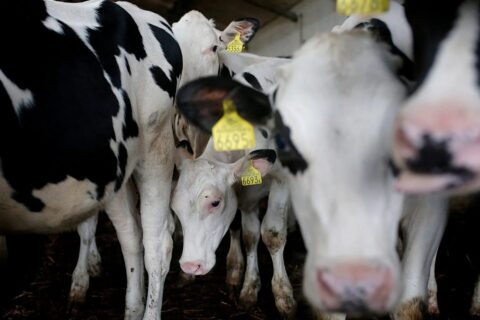Explainer
Goodbye, ‘Soy Boys.’ Hello, Swole Vegans.
Diet•15 min read
Perspective
Maintain a strong immune system during the pandemic by consuming nourishing foods while avoiding dangerous foods, like dairy, that worsen respiratory health problems.

Perspective • Diet • Health

Words by Leila Dehghan
The world was stunned by the recent news that British Prime Minister Boris Johnson had contracted the novel coronavirus. After his discharge from the hospital on April 12, Johnson gave an impassioned speech in an attempt to convince British citizens that the U.K. had passed the disease’s peak infection rate. However, his heavy gasping and failure to draw a full breath did little to bolster British morale.
Many countries are now starting to lift their COVID-19 lockdowns and allowing people to move about more freely. Since there is no coronavirus vaccine and experts hypothesize that more than 80 percent of all Americans and Brits will contract the disease, understanding how to mitigate and manage COVID-19 symptoms is necessary. Effectively fighting any disease requires maintaining a strong immune system, which, as numerous studies suggest, requires consuming nourishing foods while avoiding those that cause health problems. One food group in particular, dairy, has several negative impacts on human health.
COVID-19 is a highly contagious respiratory disease. An April 2020 study published in the New England Journal of Medicine finds that over 86 percent of infected patients exhibit lung abnormalities, as revealed by chest scans showing inflamed lungs with white patches that represent clogged mucus. For this majority of patients, sticky mucus fills up the small air sacs in the lungs, called alveoli, and causes breathing difficulties that may require mechanical ventilation. By proactively taking steps to maximize respiratory health, individuals—especially those with pre-existing respiratory conditions who face higher risks of death—can increase their chances of survival should they become infected.
Avoiding dairy products can help to prevent or manage respiratory issues. A 2019 review explains how dairy milk consumption increases mucus production, potentially leading to shortness of breath or other respiratory problems. During digestion, the protein in milk, called casein, breaks down into casomorphin, an opioid-like compound that triggers the secretion of mucus. The Mayo Clinic, a renowned medical nonprofit organisation, supports the hypothesis that dairy milk makes phlegm thicker in addition to stimulating its increased production. The Lung Health Institute lists dairy just after red meat as a key food that produces mucus, noting that avoiding dairy can help to ease chronic problems with excessive mucus. Studies also link dairy consumption with both a higher risk for developing asthma and increased breathlessness during asthma attacks. Despite so much credible evidence that removing dairy from human diets helps to ease respiratory symptoms, the dairy industry continues to claim otherwise by citing misleading studies, many of which are funded by the dairy industry itself.
The negative effects of dairy consumption extend well beyond the realm of human health concerns, as dairy farming has an appalling impact on animal welfare. A cow, like any other female mammal, only produces milk after giving birth. Farmers control dairy cows’ reproductive cycles, usually by unnaturally exciting bulls and extracting their semen, which the farmers then use to artificially impregnate female cows using their fists. After a mother cow gives birth, her baby is routinely separated from her within 24 hours to ensure that a maximum amount of her milk is sold to humans. The mother cow often bellows for days after being separated from her newborn baby. If the baby is male, and therefore unable to produce milk, he is either killed for veal or sold to be raised for beef. If female, the calf joins the milking herd and endures the same cycle of suffering as her mother: forced impregnation and the theft of her babies, among other abuses and injustices. A cow can naturally live for up to 20 years, but dairy cows are commonly slaughtered after just five years, once their milk production declines. Their short, miserable lives consist of being confined to crowded, filthy concrete barns, attached to mechanical milking machines for many hours each day.
Dairy farming is also severely damaging to the natural environment; by itself, the dairy industry is annually responsible for at least four percent of global greenhouse gas emissions. About two-thirds of dairy’s self-reported emissions come from the methane produced by cows’ ruminations; the average dairy cow annually produces up to 400 litres of methane. (Methane’s chemical shape makes it very effective at trapping heat and therefore warming the planet; more than 20 percent of global warming is attributed to methane emissions.) Another 10 percent of the dairy industry’s emissions stems from the nitrous oxide produced by cows’ dung and urine. The remainder of the self-reported emissions are generated by nitrogen leaching—which occurs when the nitrogen from dung and urine depletes soil fertility, producing nitrous oxide as a byproduct—and electricity usage on dairy farms. But beyond what the industry self-reports, dairy’s actual emissions are likely much higher. A 2018 joint report by the farming advocacy group GRAIN and the Institute for Agriculture and Trade Policy finds that the world’s biggest climate polluters are the meat and dairy industries, which fail to properly report their annual emissions by omitting those emissions produced by manure. The report estimates that, in 2016, the world’s top 20 meat and dairy companies were responsible for greenhouse gas emissions that exceeded the total emissions produced by Germany, Europe’s biggest climate polluter, in the same year. The manure produced by a dairy farm of just 200 cows can emit as much nitrogen annually as the sewage produced by a London-sized metropolis—a startling comparison when considering that 1.8 million dairy cows reside just in the U.K. Nitrogen pollution negatively impacts biodiversity, degrades water and air quality, and accelerates global warming.
The dairy industry uses a large proportion of global natural resources, including ample quantities of freshwater. Dairies require water to keep cows hydrated, for cooling milk to reduce bacteria counts, and to clean equipment and buildings, but the vast majority of the industry’s water usage—98 percent—is associated with growing the cows’ food. When factoring in the water required to produce animal feed, a staggering 1,020 litres of water are needed to produce a single litre of cow milk. Dairy farming’s destructive ecological impacts and intensive natural resource use continue to increase as the industry grows.
Animal agriculture, dairy included, poses significant risks to public health by unleashing new, virulent strains of infectious diseases. The novel coronavirus is just the most recent on a long list of viruses that have mutated and transmitted from animals to humans. The U.K.’s Creutzfeldt-Jakob epidemic, which spanned 16 years from 1980 to 1996, resulted from humans’ consumption of infected beef. The Independent reports that the 2009 swine flu pandemic originated from pigs, the 1997 bird flu from poultry, and the 1976 outbreak of Ebola virus from monkeys. Animal agriculture’s extensive use of antibiotic drugs to prevent infections and promote animal growth is contributing to increasing antibiotic resistance in humans and encouraging the emergence of treatment-resistant “superbugs.” Significantly reducing the risk of future pandemics and other serious public health crises requires the widespread closure of dairy farms and other animal farming operations.
A few months before being infected with COVID-19, Boris Johnson ceremoniously delivered cows’ milk to a U.K. voter while wearing a milkman jacket. He spoke of “real risks” threatening the country but failed to mention the many risks associated with the dairy product in his hand. Public awareness is rising in regard to the dangers of dairy, despite the industry’s denial of credible data against dairy consumption. Eliminating dairy may sound like a radical idea—just like the idea of closing schools and shops and staying home for weeks on end was until recently. This pandemic, though devastating, demonstrates just how quickly drastic measures can be enforced in times of crisis. Now is the time to take just as seriously the risks that dairy poses to human health, our planet, and the animals. Let’s ditch dairy for good.